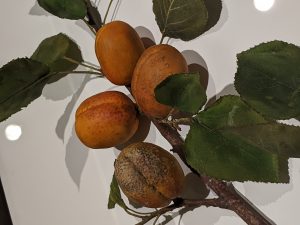by Vanessa Formato
 All these fruits are dying. Wisps of grey mold stretch out from the bottom of a sickly, shriveled strawberry. Plums blush an unnatural shade of teal. A pockmarked peach hangs from a branch, the bark discolored, its leaves curled and scaly. But what makes for a ghastly discovery on an apple picking excursion becomes a work of art in Harvard Museum of Natural History’s Glass Flowers room. This autumn, celebrate the year’s most macabre season with a visit to Fruits in Decay, a special exhibit of botanical blight and beauty.
All these fruits are dying. Wisps of grey mold stretch out from the bottom of a sickly, shriveled strawberry. Plums blush an unnatural shade of teal. A pockmarked peach hangs from a branch, the bark discolored, its leaves curled and scaly. But what makes for a ghastly discovery on an apple picking excursion becomes a work of art in Harvard Museum of Natural History’s Glass Flowers room. This autumn, celebrate the year’s most macabre season with a visit to Fruits in Decay, a special exhibit of botanical blight and beauty.
The exhibition marks the first time in almost twenty years that these unique models will be on show as part of the Ware Collection of Blaschka Glass Models of Plants. The Ware Collection, often simply referred to as the Glass Flowers, is made up of 4,300 blown glass recreations of plant life spanning nearly 800 species, all crafted by renowned glass artisans Leopold and Rudolf Blaschka between 1887 and 1936. The first director of Harvard’s Botanical Museum, Professor George Lincoln Goodale, was inspired to commission these stunning models after observing the Blaschkas’ realistic glass models of marine life that were already a prized part of Harvard’s collections. Goodale saw the potential for similar models to illustrate the beauty and complexity of plant life for both his students and the curious public. At the time, botanists-in-training primarily relied on delicately preserved plant specimens and papier-mâché scientific models.
With the help of funding from Mary Lee and Eizabeth C. Ware, Leopold and Rudolf Blaschka created the highly realistic flowers in their Dresden, Germany, workshop, through masterful heat shaping and glass blowing techniques. In order to achieve the plants’ vivid hues, the Blaschkas used a combination of colored glass and cold painting. This painstaking process certainly paid off: to this day, the Glass Flowers are among the museum’s most unique and treasured collections, and a consistent crowd-pleaser. During my time with Fruits in Decay, the gallery was never empty, and visitors eagerly engaged with docents ready to explain the history and construction of the flowers. “Are they really glass?” is a frequent question you overhear. The models are part teaching tool, part optical illusion.
The mold-ravaged berries and blighted pears of Fruits in Decay were all created by Rudolf Blaschka toward the end of his life, between 1924 and 1932, as part of a commission by then-Director of the Botanical Museum Oakes Ames. Concerned about the aging glass artist’s ability to pull off the ambitious project, Ames sent Mary Lee Ware to his Dresden studio to observe Blaschka’s creative process. Ware captured this experience, which she described as “breathless to watch,” in a letter to Ames, now excerpted and displayed on panels alongside the fruits themselves. Reading Ware’s firsthand account of the studio and Rudolf’s meticulous work is transporting, and it will surely enrich visitors’ understanding of the models as an artistic accomplishment.
Of course, the fruits encourage visitors not only to find the beauty in unexpected places but to learn more about the depth of our connection to the natural world. They model a variety of botanical ailments and injuries, from mold to fire blight, soft rot to frost damage, that can have a profound effect on daily life, an idea that feels especially poignant in a time when the effects of climate change and the importance of sustainability are increasingly urgent. In a video about the special exhibit, Donald H. Pfister, curator of the Farlow Library and Herbarium of Cryptogamic Botany and Asa Gray Professor of Systematic Botany, notes that one of the most “topical and important” lessons visitors can take from the collection is a newfound appreciation of “food security and food sources.”
“It’s another way to reach out and reach the public,” says Pfister, “and because of its beauty, because of the rarity of these models, and because of the stories that we can tell around the apples and their diseases, we think that the public will leave with a broader appreciation of both museums and of biology of plants.”
When you’ve finished taking in these fuzzy fruits, be sure to venture further into the museum, where you can see the Blaschka models of invertebrate animals on display.
For more information about Fruits in Decay and the Glass Flowers, visit:
https://hmnh.harvard.edu/fruits-decay
https://www.youtube.com/watch?v=v6ZXr69I16g
